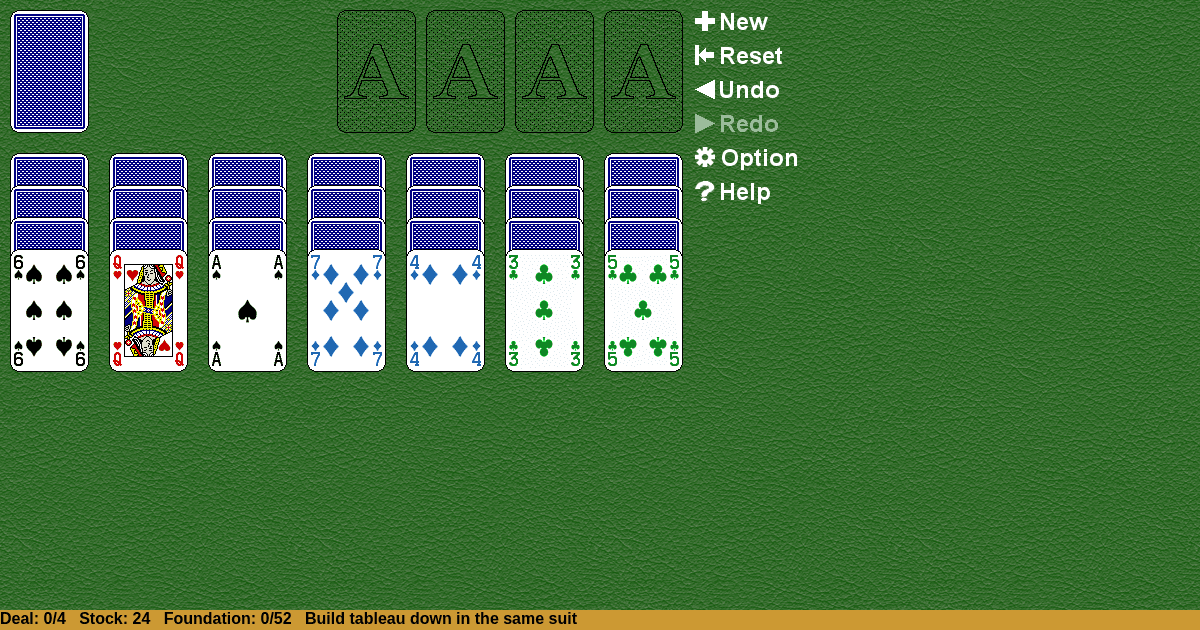Dnieper
Home |
How to play |
FAQ |
About
How to play Dnieper?
Game Objective:
The primary goal in Dnieper Solitaire is to move all cards from the tableau and stock to the foundation piles, building each foundation in ascending order by suit from Ace through King.
Setup & Layout:
- Deck: Use a standard 52-card deck with no jokers.
- Tableau: Deal cards into seven columns (tableau piles). From left to right:
- The first column receives 1 card (face up).
- The second column receives 2 cards (top card face up, bottom card face down).
- The third column receives 3 cards (top card face up, others face down).
- Continue this pattern until the seventh column, which has 7 cards (top card face up, the rest face down).
- Foundations: Four empty piles above the tableau, one for each suit. These start empty and are built up from Ace to King.
- Stock: The remaining cards after dealing the tableau are placed face down in a single stack called the stock pile.
- Waste (Talon): Cards from the stock that cannot be played immediately are placed face up in a separate pile called the waste or talon.
- Face-Up/Face-Down: Only the top card of each tableau pile is face up; all other tableau cards are face down. All stock cards are face down until drawn.
Dnieper Solitaire Rules:
- Card Movement Principles:
- Cards can be moved among tableau piles, from tableau to foundation, and from stock/waste to tableau or foundation.
- Only face-up cards are eligible for movement.
- Building Sequences in Tableau:
- Build tableau piles in descending order, alternating colors (red on black, black on red).
- Example: Place a 9 of hearts (red) on a 10 of spades (black).
- You may move a sequence of cards if they are in correct descending order and alternating colors.
- Foundation Building:
- Foundations are built up by suit from Ace to King.
- Only Aces can start a foundation pile.
- Moving Cards:
- Only the top card of the waste pile can be played.
- When a face-down card is exposed in the tableau, flip it face up immediately.
- Only Kings (or sequences starting with a King) can be moved into empty tableau spaces.
Gameplay:
- Turn Sequence:
- Move available Aces to the foundations as soon as possible.
- Build tableau sequences by moving cards onto cards of opposite color and one rank higher.
- Move sequences of cards within the tableau if they follow the descending, alternating color rule.
- When no moves are possible, draw cards from the stock pile:
- Draw three cards at a time from the stock, placing them face up in the waste pile.
- Only the top card of the waste pile may be played.
- If the stock is exhausted, turn the waste pile over (without shuffling) to form a new stock pile.
- Unblocking Cards:
- When you move a face-up card from a tableau pile, immediately flip the next face-down card in that pile face up.
- Empty Spaces:
- Only a King or a valid descending sequence starting with a King may be placed in an empty tableau pile.
Winning & Losing Conditions:
- Winning Condition:
- The game is won when all cards are moved to the foundation piles, each built up in suit from Ace to King.
- Losing/Unwinnable Condition:
- The game is lost or becomes unwinnable if no legal moves remain and the stock pile has been exhausted (or, if playing with restricted redeals, the allowed redeals have been used up).
Special Rules & Edge Cases:
- Filling Empty Tableau Spaces:
- Only Kings or sequences starting with a King may fill empty tableau columns.
- Redealing Stock:
- When the stock pile runs out, turn the waste pile over to form a new stock. Do not shuffle.
- In some variants, there may be a limit on the number of times the stock can be redealt (e.g., three times in "Vegas rules").
- Sequence Movement:
- You may move entire sequences within the tableau if they are in descending order and alternate colors.
- Face-Down Cards:
- Whenever a face-down card is exposed (no cards above it in its pile), flip it face up immediately.
Note: While "Dnieper Solitaire" is often referenced as a variant of Klondike Solitaire, the rules above reflect the standard Klondike rules, which are the closest documented set matching the available sources. If a distinct "Dnieper Solitaire" ruleset emerges in official documentation, those rules should take precedence.

Solitaire Collection
About Dnieper
Rate (Dnieper)
4.7 / 5
1,916 votes



























































